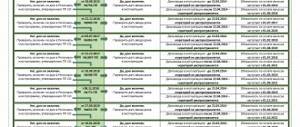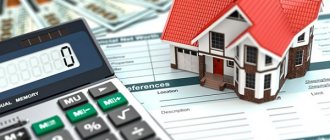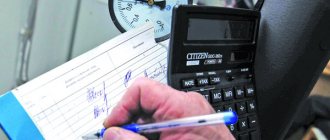Review of the form
The Ministry of Construction has approved a sample form (Order No. 43/pr [1] dated January 26, 2018), uniform for all housing and communal services organizations. The sample given in the order consists of the following parts:
- Document header – title, payment identifier of the document, recognized by GIS Housing and Public Utilities, personal account.
- Section 1 – personal personal data of the payer and information about the payee (management company or HOA).
- Section 2 – meter readings.
- Section 3 is a detailed list of utilities, including for general house needs, with their cost terms. Comparison when applying increasing factors. Results of recalculations. Availability of benefits, fines and penalties. Summary data. Bank details of the management company, necessary information for payment. Bar code.
- Section 4 contains background information.
- Section 5 is completed for payments in installments.
- Section 6 – for recalculations.
Let's take a closer look at some parts of the document to help decipher the contents of the payment receipt.
I am looking for you
The easiest way to find out the tariffs at which you pay for housing and communal services is from the management company - they are usually posted on its website along with documents that justify why they charge you exactly that much. In addition, such information is posted on the websites of city administrations - in Moscow this is the city hall portal mos.ru. The utility calculator on the website of the Federal Antimonopoly Service can also help; with its help, you can calculate how much your utility bill should be and understand whether they are charging you too much.
Infographics "RG" / Anton Perepletchikov / Alexander Meleshenko
Fee calculation
Section 3 is the most voluminous and most difficult to understand. It is there that each type of utility service is listed line by line - the tariff is multiplied by the amount of resources consumed, and the accrued amount is obtained. Further clarifications follow; In order to make it clearer to the payer exactly how the amount to be paid is added up, new columns and lines were introduced. What is included in the text:
- The “contents” line indicates exactly what resources were consumed for general house needs, their volume and the amount to be paid.
- If the consumer is charged according to an increasing coefficient, then the size of the coefficient shows the amount accrued due to its application.
- Recalculations - reflect the total amount of decrease/increase based on the consumer’s application (with supporting documents), or on the available grounds of the Criminal Code. What this column means is given in section 6 of the document. The type of service for which the recalculation was made, the grounds, and the amount are written there in detail.
- The balance of the unpaid payment or advance payment;
- Columns on fines have been introduced to reflect their size to the payer - they separately indicate sanctions for the consumer and fines for the performer (for example, for a poorly rendered service).
After these numbers are added up, the result for payment is obtained.
What coding system is used for receipts for payment of housing and communal services?
Most often, housing and communal services receipts use the general symbology CODE-128; in this symbology, you can encode from 1 to 70 characters - Latin letters and numbers, while in EAN-13 only numbers are used. EAN-13 symbols are in most cases used by stores, retail chains and other sales agents for the sale of products and their warehouse movement.
But it is also possible to use EAN-13 encoding, which is not logical, but may well be possible. But if this system is used by housing and communal services organizations, then the first digit in the code should be 2. For a receipt for housing and communal services, an EAN-13 barcode can either be used (which is not logical, but it may well be), but then the first digit in the code should be number 2, which means that the organization uses EAN-13 for internal document flow. In this case, codes within a given organization can mean anything - at least a document, at least some kind of internal product, or maybe even the inventory number of some laptop or something else.
Retail chains mainly use internal coding for goods by weight and for those goods that were created for sale only within a given retail chain (on some products there is such an inscription - “ Only for sale in the Magnit retail chain ,” for example).
When you weigh goods in a retail chain, the retail scales generate a barcode for you and you stick it on the bag, this barcode always starts with the number 2
Moreover, in the retail network in which you weighed the product and stuck a barcode on it, this barcode will designate one product, but in another network this code may not yet exist at all, or it will designate a different product, etc. etc., because this is the internal coding of the organization.
The article will be useful: Recalculations of management companies/homeowners associations after accruals according to standards and average monthly readings: are they required to make a recalculation if the consumer did not submit readings?
I hope now we have closed the question: why does the barcode on my receipt show the country of origin - France or the USA?
reference Information
Introduced for the purpose of checking by consumers the total amount of resources used by the management company and the payment for them in an apartment building.
By installments
To be completed only for those payers who have made installment payments.
Details of installment payment for rent are provided.
After all the calculations, the results are displayed - how much money the consumer needs to pay per month. The form of the document is designed so that each payer can independently view and verify each item in the invoice. The form is used by specialized companies - management or resource supply organizations. It contains minimal data. If necessary, the form can be supplemented. If the payer does not understand certain items or does not agree with them, he must contact representatives of the company that filled out the receipt.
What are we paying for? We sort out utility bills
Every month we receive a payment document/receipt for payment of fees for the provision of utility services. From time to time, residents have a question: where did this or that amount in the payment come from? To learn how to figure out on your own where the numbers and lines come from, let’s look at the receipt for utility services in detail.
General receipt
SECTION 1. INFORMATION ABOUT THE PAYER
.
The top line displays the billing period - the month for which the accrual was made. The section also contains personal information about the owner, address, information about the area of the apartment. The area of housing plays a role in calculating fees
for the maintenance and repair of a house, as well as in calculating the amount of resources spent on maintaining common property, that is, the amount of water that was spent on washing floors, walls, windows in the entrance, watering flower beds or, for example, electricity - for the operation of the elevator and light bulbs.
Information about the payer Common property includes: inter-apartment stairwells; stairs; elevators; elevator and other shafts; corridors; attics; basements, roofs; mechanical, electrical, plumbing and other equipment located outside or inside the house and serving more than one room; the plot of land on which the house is located, with elements of landscaping and landscaping. Next to the “Area” section there is a column “Number of residents/registered”
. It is important for those who do not have individual metering devices installed. They pay for utilities and services according to the standard established by the regional government. The standard depends on the number of people registered in the apartment, and not on actual consumption.
The standard is a conditional value calculated on the basis of the average human needs for water, heat, and electricity consumption.
Established by the constituent entities of the Russian Federation. Immediately below the area data are payment requirements for the tenant.
If you see any amount in the
“Underpayment for the billing period”
, although you are sure that you have paid every penny, then there is no need to panic. Payments could be delayed, for example, at the bank. In any case, this money will be taken into account when creating the payment for the next month.
Always keep your receipts; they will help you prove that you paid your bills in unexpected and controversial situations. The law in Russia does not provide for a clear storage period. Here it is recommended to take into account the limitation period when the plaintiff can sue the debtor. According to Art. 196 of the Civil Code of the Russian Federation, it is three years.
The line below is the amount to be paid for the billing period.
These are accruals for the past month, based on meter readings in the apartment.
A detailed description of this amount is reflected in section 3.
Below are “Payments for the billing period”
— they indicate payments received for the previous month.
Below them in bold font is a summary line that contains all your monetary obligations to the company for the current month, taking into account past debts or overpayments
.
This is the amount that needs to be paid.
The date of the last payment is indicated next to it - the day when you last paid for housing and communal services.
The same section contains the personal account number of the virtual subscriber service
. This number and password are needed to enter the homeowner’s personal account on the website www.krasinform.ru or krk-online.sibgenco.ru - the address is indicated in the receipt. In your personal account, you can submit cold and hot water meter readings, view your payment history and all your receipts for the last year.
Under no circumstances tell anyone your personal account number or password.
If you suddenly think that someone knows your password, you should change it. You also need to know your personal account number when paying for services through payment terminals. Using them is quite simple, but keep in mind that you may be charged a commission. SECTION 2. INFORMATION ABOUT THE SERVICE PROVIDER AND PAYMENT RECIPIENT
Contains information about the organization that provides utility services: heat, water, heating, electricity, gas and other resources.
Information about the service provider and the payee
JSC Yenisei Territorial Generating Company (TGK-13) (part of the Siberian Generating Company) - heating and hot water;
LLC "Kraskom" - cold water and wastewater disposal.
The line below contains the name and details of the payment recipient. LLC "Siberian Heat Sales Company" (part of the structure of SGC).
SECTION 3. CALCULATION OF THE AMOUNT OF PAYMENT FOR PUBLIC SERVICES.
The next six lines relate to utilities that apartment residents consume individually, that is, within their living space.
Calculation of utility fees class=”aligncenter” width=”1024″ height=”222″[/img]
In the third column
The volume of consumption for heating, hot and cold water, and water disposal is given, according to meter readings.
Fourth
- refers to the resources spent on maintaining common property. The management company makes the accruals for them and, therefore, it will display them in its receipt.
Fifth
- tariffs established by the state - the Ministry of Tariff Policy of the Krasnoyarsk Territory, for each resource.
If we multiply the indicators of columns 3 and 5, we get the amount of payment for utilities - This is the sixth column
.
Help: with installed metering devices, residents pay only for actual consumption, so they can reduce water or electricity costs if necessary. In the absence of meters, payment occurs according to the standards established by the government of the Krasnoyarsk Territory. The amount of payment depends on the number of people registered in the apartment.
The penultimate line in the third section “ Total for utilities Total payable for the billing period ”
- the sum of all charges and recalculations for utilities for a single apartment. If you have no debts, then it will match the amount in Section 1.
Information: All tariffs in receipts are set on the basis of regulatory documents approved by the government agency. Tariff is a conditional value that determines how much 1 cubic meter of water, 1 Gcal of heat, 1 kilowatt of electricity costs. It is established by a state body - the Ministry of Tariff Policy of the Krasnoyarsk Territory.
SECTION 4. REFERENCE INFORMATION
Help information in the payment order
The second column contains information about water consumption standards
. This information is intended for those who do not have individual meters installed. The figure will remain unchanged until the standard changes. Those residents who have acquired meters can see the transmitted readings in the fourth, and the volume of consumption in the fifth column of the receipt. The date of the last reading is indicated in the third column.
For residents whose apartments are not equipped with meters, from January 1, 2017, the amount of the standard for water and electricity increased by 1.5 times.
Below are consumption standards for general house needs (we wrote about what this is above) and the volume of resource consumption by the house as a whole, based on the readings of common house meters, if they are installed in the house.
SECTION 5. INFORMATION FOR PAYER
In the fifth section, as a rule, residents are warned about upcoming recalculations/adjustments, tariff changes, the deadline for checking meters and other important events that the homeowner needs to know about. For example, in the receipt that we give as an example, residents are informed that as of 01/01/2019, tariffs for heating, hot and cold water and sanitation have been changed.
Information for the payer
SECTION 6. INFORMATION ABOUT RECALCULATIONS
Contains information about all recalculations. Recalculation for housing and communal services
represents a deduction of previously overpaid funds or an additional payment for the actually consumed resource, both for individual consumption and consumption of the home as a whole. This is the case if communal meters are installed.
According to Federal Law No. 261 “On energy saving and increasing energy efficiency and on introducing amendments to certain legislative acts of the Russian Federation,” all residential buildings and apartments must be equipped with water, heat and electricity meters.
Information about recalculations
Payment for residential premises and utilities is paid monthly by the tenth day of the month following the expiration, unless a different period is established by the apartment building management agreement.
Features and changes
The form of any payment receipt always contains an indication of the year and month for which the subscriber is billed for services. In this case, there can be two charging options:
- For the current month.
- For the previous month.
It all depends on what agreement was concluded with the management company. Resources consumed according to the installed meter are paid according to actual consumption: the subscriber takes monthly readings, enters them into the receipt and pays for the volume used.
If there are no meters, there is a fixed tariff for paying for energy resources, which is set by utility services in accordance with the requirements of the Russian government and legal norms. In this case, the size of the fee directly depends on the area of the room and how many people are registered in it. If there is incorrect data, the payer of services may submit a request for recalculation.
It should be noted that since the billing period for 2017-2018, the standard form of receipts has been supplemented with a new line about payment for the collection and removal of MSW (municipal solid waste). This fact did not have any impact on the final payment amount, but the service itself was provided by the hotel's utility service point. This change is due to the reformation in the system of recycling and removal of garbage waste, since now such responsibility is assigned to regional structures.
What is included in MOS electricity?
Article 36 of the Housing Code of the Russian Federation includes in common areas (MOP): elevator, corridors, platforms, attics, basements, etc. non-residential premises in which electricity is used. In accordance with Art. 158 of the housing legislation, each owner of an apartment in a multi-storey building must regularly pay housing and communal services receipts related to utilities and the maintenance of his own home, as well as take a share in the care of the common space.
For your information
Electricity consumed by light bulbs on sites and in basements was always paid for, but at the expense of the “housing maintenance” line. Houses equipped with common metering devices do not experience difficulties in calculating payments for MOP, since we are talking about actual expenses. And residents of old buildings, which in most cases do not have meters, are outraged by too high payments. In almost all regions, the standard is 7 kW per month for MOP in a building that is not equipped with an elevator and approximately 14 kW if the number of floors of the building requires a lifting mechanism.









